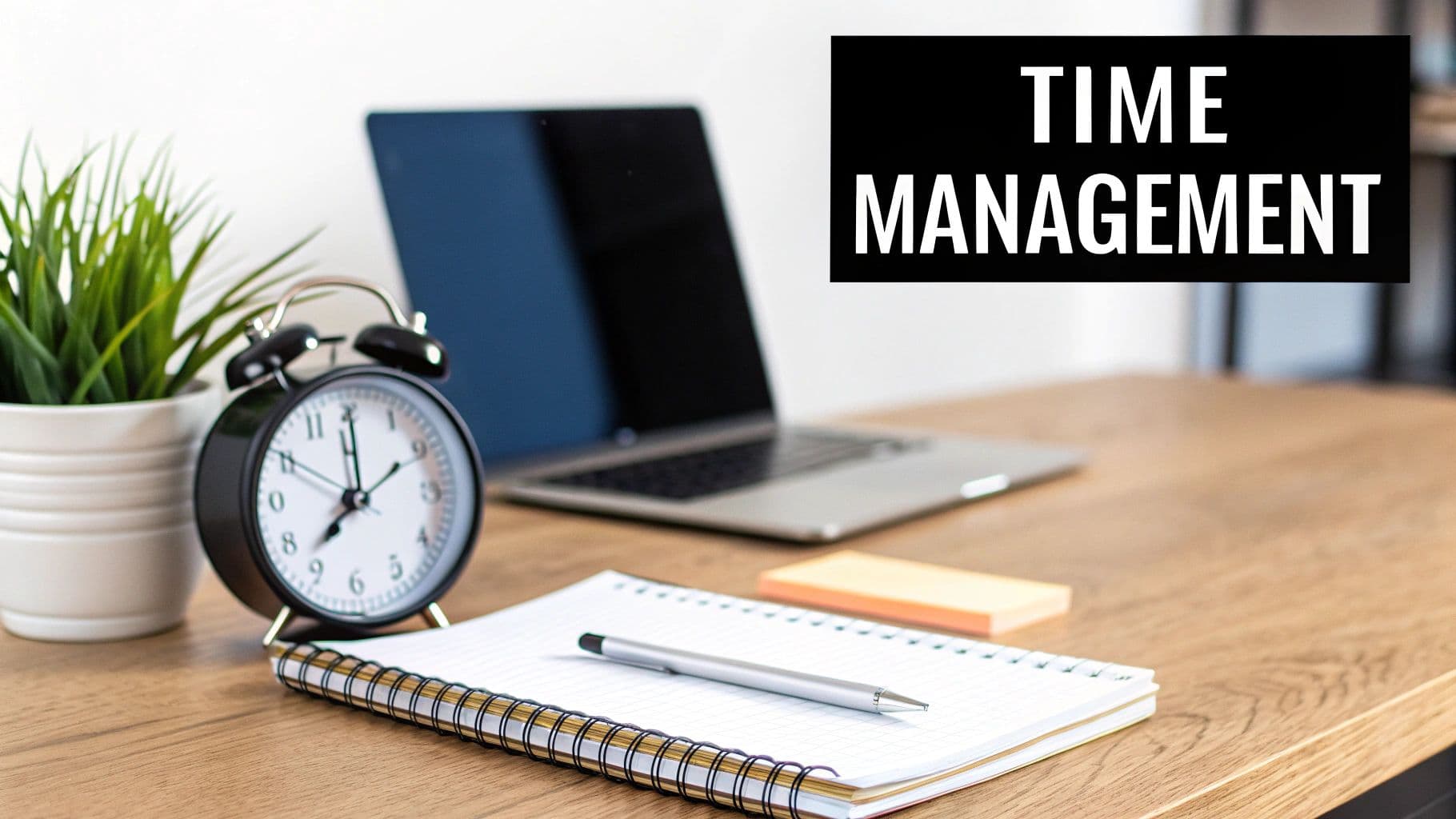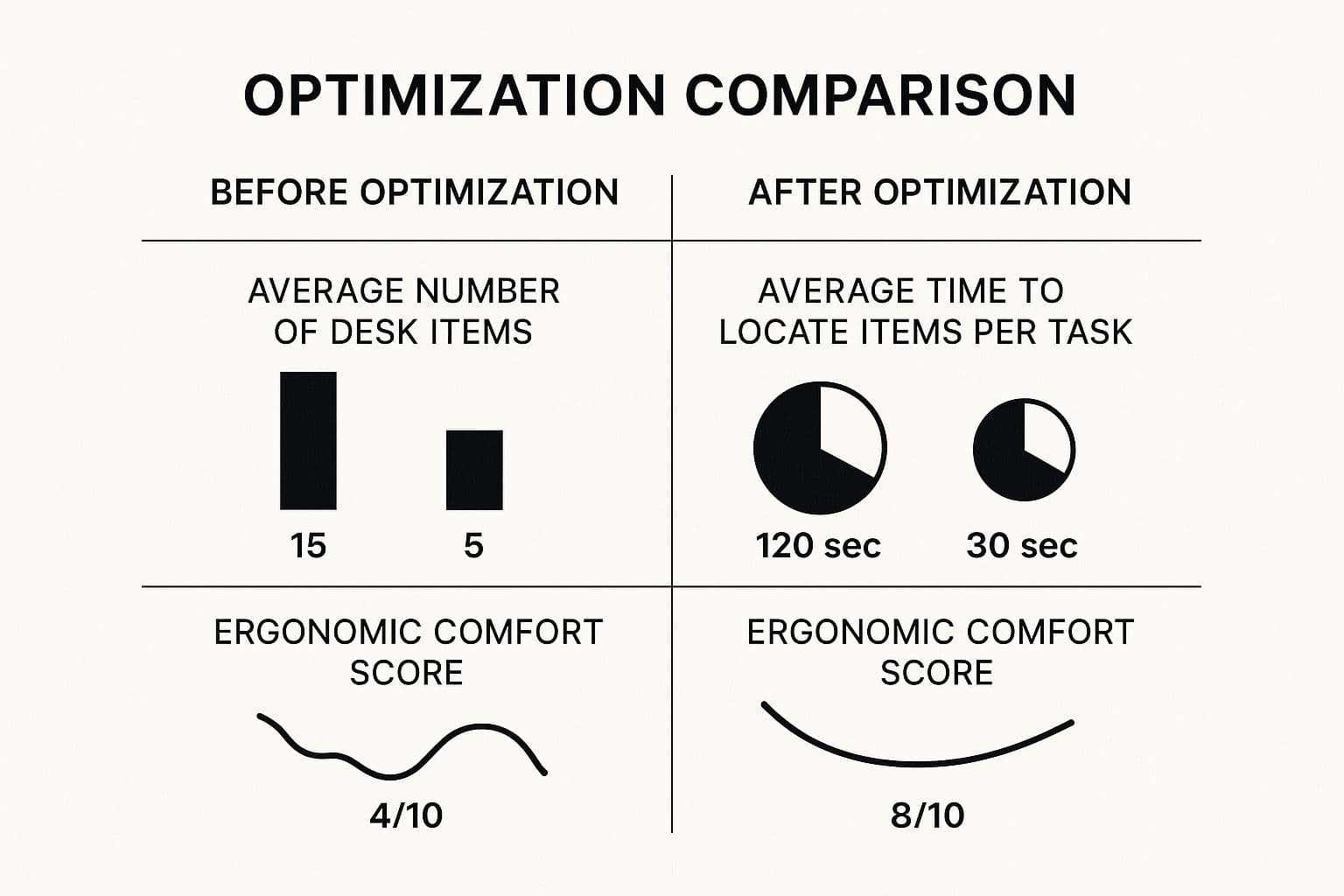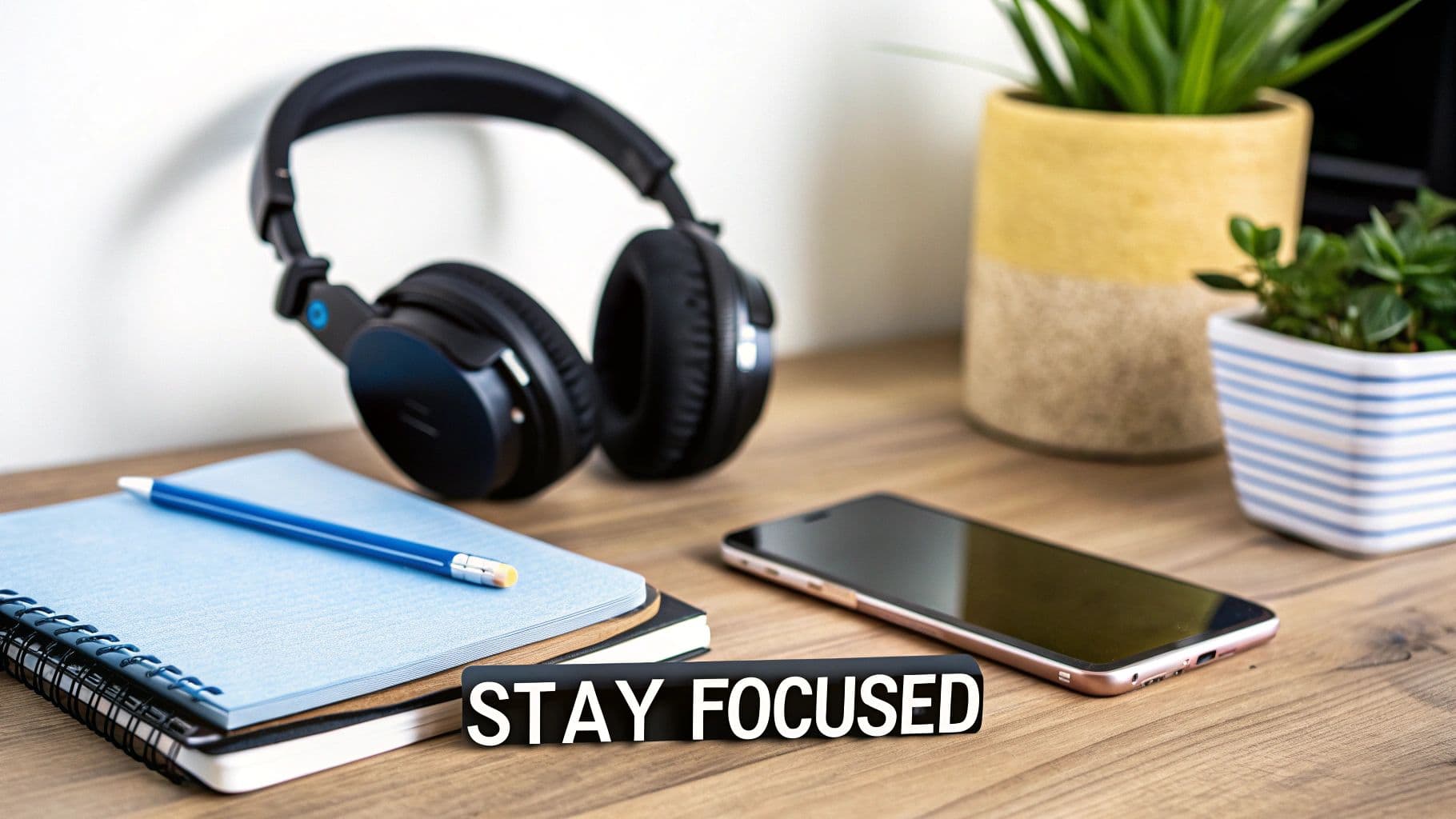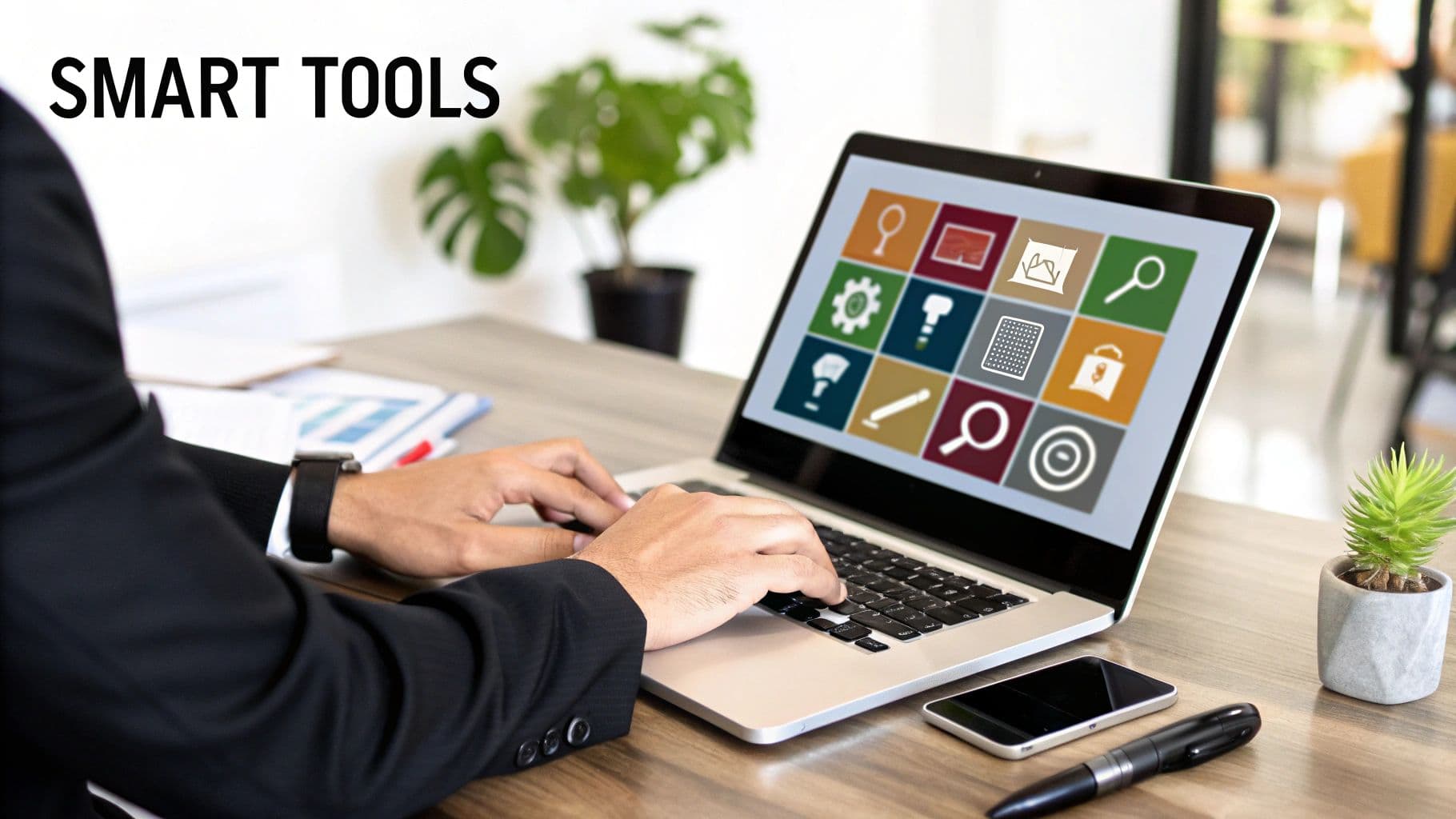If you're serious about getting more done at work, it's time to stop thinking about "working harder." The real keys are mastering your attention, smartly automating the grunt work, and fiercely protecting your well-being. This isn't about managing your time; it's about managing your energy and focus.
Let’s quickly look at the core ideas we'll be exploring. These three pillars are the foundation for a more effective and sustainable way of working.
Three Pillars of Enhanced Workplace Productivity
These strategies work together to create a powerful system for not just getting more done, but for doing your best work without burning out.
The Real Reason You Feel Busy But Not Productive
Does this sound familiar? You walk in on Monday with a perfectly good to-do list, ready to go. By Friday, you're completely drained from a week packed with back-to-back meetings and a relentless flood of emails, but your most important tasks are still sitting right there, untouched.
If you're nodding along, you're not alone. This hamster-wheel feeling of being constantly busy but never actually productive is a modern workplace epidemic.

The problem isn't that you're not trying hard enough. The issue is that the old playbook—just put in more hours—is completely broken. It's a losing game in a world of constant digital pings and the messy, blurred lines of remote and hybrid work.
The Modern Productivity Challenge
The real challenge isn't about cramming more work into your day; it's about directing your energy to the things that actually move the needle. And frankly, that's getting harder. The numbers paint a pretty stark picture of the disconnect between all the effort we're putting in and what we're actually getting out of it.
Believe it or not, global employee productivity growth in 2024 was a tiny 0.4%. Even in the U.S., where things looked a bit better, only 21% of workers said they felt engaged at their jobs. This points to that "quiet quitting" trend we've all been hearing about. You can dig into more of these employee productivity statistics on archieapp.co.
What this data screams is that when people are checked out, no amount of fancy software or long hours is going to make a difference.
A Smarter Path Forward
To actually improve productivity at work, we have to tackle what's really causing the inefficiency. This guide is your roadmap to taking back control of your time and energy, and it all comes down to focusing on those three core pillars we mentioned.
- Mastering Focus: We'll get into real techniques for shutting out the noise and getting into a state of deep work. This is where you produce your best stuff in a fraction of the time.
- Strategic Automation: I'll show you how to identify the repetitive, soul-crushing tasks on your plate and hand them over to technology and AI. This frees you up for the interesting, high-impact work you were actually hired to do.
- Sustainable Performance: We’ll talk about building habits that keep you from burning out. This is about creating a work style that lets you stay sharp, creative, and effective for the long haul.
Throughout this guide, we'll break down practical, actionable strategies for each of these areas. The goal is to help you shift from feeling perpetually swamped to being genuinely, satisfyingly productive.
How to Master Your Focus and Defeat Distractions
In a world practically engineered for interruption, the ability to truly concentrate has become a superpower. But let’s be honest, the standard advice to "just turn off your phone" barely scratches the surface. If you want to make a real dent in your workday, you need to build a system that actively defends your attention.
The modern office is a minefield of distractions. It's a highly interruptive environment where the average employee gets sidetracked roughly every three minutes. What’s truly staggering is that it can take a full 23 minutes to get back into a state of deep focus after each one. You can dig into more of these workplace productivity statistics on eptura.com.
This constant context-switching is the quiet killer of productivity. Every time you bounce from a report to an email, then over to a Slack notification, your brain pays a price. It has to re-engage and re-orient, which drains your mental energy and slows you down far more than you realize.
Embrace Time Blocking for Deep Work
Stop letting your inbox run your day. The best way to take back control is with time blocking. This isn't just a fancy to-do list; it's about giving every minute of your day a specific job to do.
Let's say you're a marketing manager juggling creative strategy, data analysis, and team check-ins. Instead of trying to wedge creative work into tiny, unpredictable gaps, you could block out a non-negotiable two-hour "Content Creation" session every Tuesday and Thursday morning.
During that protected time, you'd:
- Close your email tab. Completely. No peeking.
- Set your chat status to "Focusing" or "Do Not Disturb."
- Put your phone in a drawer or another room. Seriously.
This simple act creates a protective bubble around the deep, meaningful work that actually moves the needle. It sends a clear signal to your brain—and your colleagues—that this time is off-limits.
Use Structured Breaks to Stay Sharp
Trying to power through mental fatigue is a losing battle. Our brains simply aren't built for eight straight hours of intense focus. The secret is to work in focused sprints, not a grueling marathon. This is where a method like the Pomodoro Technique really shines.
The process is incredibly simple:
- Pick one—and only one—task to work on.
- Set a timer for 25 minutes and give it your undivided attention.
- When the timer goes off, take a real 5-minute break away from your screen.
- After four of these cycles, take a longer, more restorative break of 15-30 minutes.
This rhythm helps you sidestep the dreaded afternoon slump by building recovery right into your workflow. Imagine a software developer using this to debug a tricky piece of code. The intense 25-minute bursts keep their output sharp, while the quick breaks offer a mental reset that often helps them spot the solution faster.
Ultimately, mastering your focus isn't about raw willpower; it's about having the right structure in place.
Using Technology and AI to Automate Your Workflow
Technology can be a real double-edged sword. On one hand, it can pull your focus in a million different directions. On the other, it can be your single greatest ally in getting more done. The trick is to be deliberate—choosing tools that handle the low-value, repetitive stuff so you can focus on the work that actually moves the needle.
Artificial intelligence, in particular, has officially left the realm of science fiction and landed squarely in our daily work lives. Just think about all the time we lose to administrative busywork. I'm talking about things like manually typing up meeting notes or trying to tame a chaotic inbox. These are exactly the kinds of tasks AI was made for.
Choosing the Right Tools for Automation
The goal isn't to download every shiny new app you see. That just leads to more noise. Instead, it’s about taking an honest look at your day and figuring out where your biggest time-sinks are. Once you know the problem, you can find a tool that solves it. The impact here is huge.
Companies that have brought AI into their workflows are seeing 72% higher productivity and 59% improved job satisfaction. It’s no wonder that around 75% of knowledge workers say AI saves them time and even helps them be more creative. The trend is clear: projections show 58% of employees will be using AI by 2025. You can dig into more of these fascinating 2025 workplace statistics on eptura.com.
A fantastic place to start is with your meetings. Imagine this: you wrap up a long client call, and within minutes, a clean, concise summary lands in your inbox, complete with action items and key decisions already pulled out. This isn't a pipe dream anymore; it’s what modern AI meeting assistants do.
A Practical Example of AI in Action
Let's look at a real-world scenario. Think about a project manager who sinks hours every single week just trying to consolidate status updates from their team and type up notes from stakeholder meetings. It's essential work, sure, but it's also mind-numbingly repetitive.
By bringing in an AI summarization tool, they can completely change that workflow. The tool can automatically record and transcribe the entire conversation, figure out who said what, and spit out an instant summary. If you've ever tried to create a transcript from scratch, our guide on Zoom meeting transcription shows just how much time and pain this one step can save.
With this single change, the project manager gets hours back every week. Now, instead of just being a note-taker, they can spend that reclaimed time on high-value work like mentoring their team, spotting project risks before they become problems, or actually planning the next big move.
The image below gives a sense of how broad AI's capabilities are, covering everything from complex problem-solving to perception.

Each of these areas represents a different opportunity to automate some part of your day-to-day work, freeing you up for more important things.
With so many AI tools out there, it can be tricky to know where to start. The key is to match the tool's function to a specific pain point in your workflow.
Comparing Productivity-Boosting AI Tools
Ultimately, the best tool is the one that solves a real problem for you. By starting with a clear pain point—like messy meeting notes or an unruly inbox—you can find a solution that delivers an immediate and noticeable boost to your daily productivity.
Why Team Productivity Starts with Great Leadership
You can have the best individual productivity hacks in the world, but they'll only get you so far. Real, lasting performance is a team effort, and the person calling the plays makes a massive difference. Think about it: a highly motivated employee can hit a wall fast if their manager is a bottleneck.

This connection between leadership and team output isn't just a gut feeling—it's backed by hard data. Study after study confirms that a manager's actions directly influence their team's engagement, drive, and overall results. A great leader is a force multiplier, creating an environment where people can truly shine.
On the flip side, a disengaged or ineffective manager can single-handedly crush a team's spirit and productivity. They muddy the waters with unclear expectations, grind everything to a halt with micromanagement, and create a culture where nobody feels safe enough to take a chance.
The Shift from Taskmaster to Performance Coach
The best leaders I've worked with aren't just dishing out tasks and checking them off a list. They’ve moved beyond that. They act more like performance coaches, focused on clearing roadblocks and empowering their people to succeed. This mindset shift is absolutely essential if you want to boost productivity across your entire team.
So what does this coaching approach actually look like? It boils down to a few key habits:
- Setting Crystal-Clear Goals: Everyone knows what winning looks like, both for their own role and for the team’s collective mission. There's no ambiguity.
- Providing Consistent Feedback: Feedback isn't a once-a-year event. It's a continuous, supportive conversation that’s all about helping people grow.
- Building Psychological Safety: This is huge. It means creating a space where people feel safe enough to speak up, admit they made a mistake, or pitch a wild idea without getting shot down.
The impact of this coaching style is staggering. Research shows that an incredible 70% of team engagement is directly linked to the manager. And yet, with 56% of managers having received zero formal leadership training, there’s a massive gap. You can dig deeper into how manager coaching impacts performance from Gallup's findings on capclaw.com.
Practical Steps for Empowering Leadership
So, how do you put this into practice? An empowering leader is always looking for friction and finding ways to eliminate it.
Let's say they notice the team is constantly bogged down by disorganized, energy-draining meetings. Instead of just letting it slide, they take action. They might roll out a clear agenda template for every meeting and introduce a tool that automates the note-taking. It’s a small change, but it frees everyone up to actually think and contribute during the discussion. If that sounds like a familiar problem, our guide on how to run effective team meetings is a great place to start.
At the end of the day, great leadership is built on a foundation of trust and support. When you give your team clear direction, the right tools, and the autonomy to do their jobs, you unlock a level of collective performance that no one person could ever achieve alone.
Building Sustainable Productivity and Avoiding Burnout
The goal isn't just a short-term burst of insane productivity that leaves you drained. Real, lasting productivity is about finding a rhythm you can maintain for the long haul without hitting that dreaded wall. It’s a mental shift from a "hustle 'til you drop" mindset to one of working strategically and with focused energy.

In a world where work is always in our pocket, setting firm boundaries has never been more critical. Burnout isn’t just feeling tired; it’s a deep state of physical and emotional exhaustion that completely tanks your motivation and effectiveness. The only way to truly sidestep it is by creating a deliberate separation between your work life and your personal life.
Think of it this way: rest isn't the enemy of productivity. It's the fuel. A well-rested mind is sharper, more creative, and far better at untangling tricky problems.
Create a Clear End to Your Workday
One of the best habits I've ever adopted is the shutdown ritual. This is just a consistent routine you follow every single day to signal to your brain, "Okay, we're done here." It's about mentally clocking out, which stops work from creeping into your evening.
Your ritual doesn't have to be complicated, just consistent. Here’s what mine looks like:
- Quick Day Review: I spend five minutes glancing over what I got done and then jot down the top one or two things I need to tackle tomorrow.
- Tidy the Workspace: A quick wipe-down and organizing my desk gives a sense of closure. It’s amazing how a clean slate in the morning changes everything.
- Log Off Completely: I don't just minimize windows; I close every single work-related tab and app. Then, I turn off all work notifications on my phone.
This simple set of actions creates a clean break, allowing you to actually recharge each night.
Embrace Flexibility and Real Breaks
I know how tempting it is to just eat lunch at your desk and keep plugging away. But that habit is a productivity killer in disguise. Taking a real break—meaning you get up and step away from your screen—is non-negotiable if you want to perform well consistently. It gives your brain a chance to reset, and you often come back with a fresh perspective.
Flexibility is a huge part of this sustainable approach. Hybrid work models have proven that when people have more control over their schedules, they perform better. In fact, employees who work from home just two days a week are not only as productive as their in-office peers but are also 33% less likely to quit. This isn't just a nice perk; it's a core component of a happy, effective team. You can dig into more of these findings on employee productivity at archieapp.co.
At the end of the day, building sustainable productivity is about working smarter, not just cramming more hours in. By setting clear boundaries, taking genuine breaks, and learning to protect your priorities, you build a work life that's not just effective, but actually fulfilling.
Turning Ideas Into Action: Your Productivity Plan
Alright, we’ve covered a lot of ground. But information is only half the battle. Real change happens when you actually do something with what you’ve learned. So, let’s build a simple, personal plan to get you started.
The biggest mistake I see people make is trying to overhaul their entire workday at once. It’s overwhelming and almost always leads to burnout. Forget that approach.


